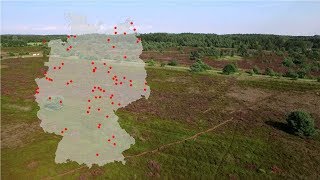Einzigartiges Holztafelbild vor dem Zerfall durch Trockenstress bewahrt
In der Brut- und Setzzeit Rücksicht auf Wildtiere nehmen
In der Brut- und Setzzeit Rücksicht auf Wildtiere nehmen

DBU Naturerbe – 70,000 hectares for nature conservation
Germany bears a special responsibility for its diverse landscapes with their animal and plant species, its national natural heritage. To preserve this heritage, the federal government is handing over up to 156,000 hectares of nationally significant land to the states, DBU Naturerbe GmbH and nature conservation associations – a unique opportunity for domestic nature conservation!
The non-profit natural heritage subsidiary of the Deutsche Bundesstiftung Umwelt (DBU), will secure 71 large-scale properties – around 70,000 hectares in ten German states – for nature conservation in the long term. These natural heritage sites, most of which are former military training areas, will be gradually handed over to DBU Naturerbe GmbH for this purpose over the next few years.
Since April 2009, the DBU subsidiary has already been responsible for on-site nature conservation measures, which it carries out in cooperation with Bundesforst employees who are familiar with the area. The main objectives of DBU Naturerbe GmbH are the promotion and conservation of the native wealth of animal and plant species in different habitats. It also aims to promote a sustainable awareness of nature among the population.
Nationales Naturerbe
Germany bears a special responsibility for its national natural heritage – its characteristic natural and cultural landscapes with their diverse habitats and native animal and plant species.
This heritage must be preserved as an essential part of our homeland, our livelihood and quality of life for future generations.
On the one hand, the “National Natural Heritage” refers to the nationwide selection of 156,000 hectares of land that is transferred free of charge from the federal government to the states, foundations and associations for permanent preservation or remains with the Federal Agency for Real Estate Tasks, where it is developed according to nature conservation objectives. However, the National Natural Heritage in the broader sense also includes protected areas and landscapes funded through nature conservation projects, as well as valuable natural areas that have already been secured for nature conservation by foundations or associations.
Germany’s natural heritage includes not only near-natural areas such as extensive beech forests, rivers and lakes, moors, coasts and mountains, but also landscape areas that have been transformed by humans and have developed into valuable habitats for wild animals and plants.
These include areas formerly used for mining or military purposes, which are important refuges for many endangered species in our densely populated country. The conservation of these rare species is of national, European and in some cases even global importance.
Germany, for example, is responsible for the global protection of large-scale beech forests, as it lies at the center of the European distribution and has a 25 percent share of the natural beech forest area.
There is also a special responsibility for the red kite, which is still relatively common here. According to estimates, about 60 percent of the worldwide population lives in Germany, while in Central Europe it is already one of the rarest birds of prey.
Historie
Military, large-scale properties in our otherwise densely populated country have been able to maintain or develop significant habitats in recent decades.
In order to secure these permanently even after they have been abandoned for use, the federal government transfers up to 156,000 hectares of valuable natural areas that would otherwise have been sold off as “National Natural Heritage” to the states, DBU Naturerbe GmbH and associations, or secures them in the federal solution at the Bundesanstalt für Immobilienaufgaben. With the first two tranches of up to 125,000 hectares, it was decided to preserve around 84,000 hectares of former military land (Bundesanstalt für Immobilienaufgaben), 28,000 hectares of small-scale natural areas (Bodenverwertungs- und verwaltungs GmbH (BVVG)), around 2,000 hectares of post-mining land (Lausitzer und Mitteldeutsche Bergbauverwaltungsgesellschaft mbH) and around 6,800 hectares of land along the Green Belt. This will be followed by another 31,000 hectares in a third wave of transmission.
The transfer of the natural heritage areas is associated with conditions such as the permanent assurance of the quality of nature conservation, the assumption of the burdens or risks due to previous use, as well as the costs for the personnel working on site.
The DBU’s non-profit subsidiary will secure about 70,000 hectares with 71 sites. In order to preserve the diversity of habitats, structures and species on the natural heritage sites, DBU Naturerbe GmbH, together with representatives of the Federal Agency for Nature Conservation and the federal states, developed ambitious nature conservation goals, which were defined in the form of 70 site-specific guiding principles.
These mission statements are part of the framework agreements with the federal government, which provide for the land to be transferred gradually over the next few years. Since April 2009, the employees of the Federal Forestry Service, who were previously active in the field, have been devoting themselves to these new nature conservation tasks on behalf of the DBU subsidiary.